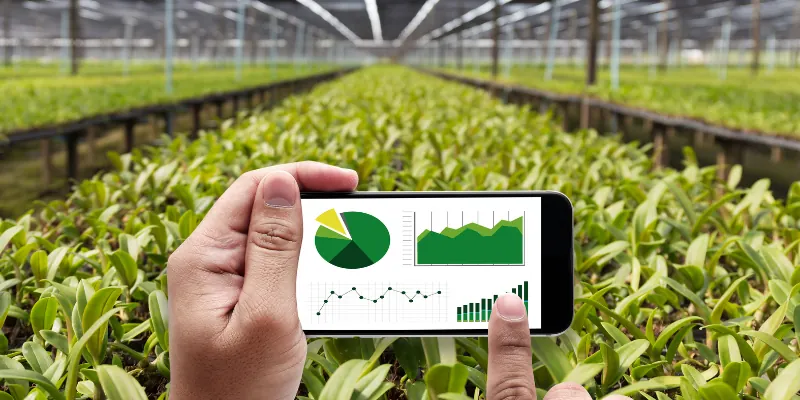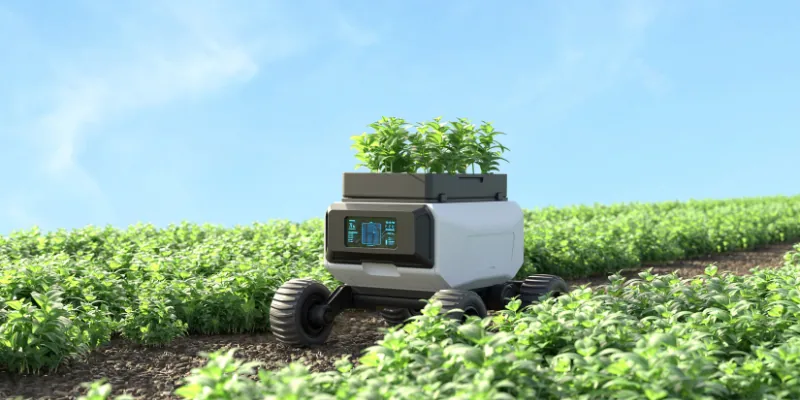Advantages of Computer in Agriculture for Smart Farming
Published: 16 Feb 2025
Computers have revolutionized many industries, and agriculture is no exception. Today, farmers are using advanced technologies like GPS systems, drones, and automated machinery to increase efficiency and productivity. With the help of computers, farmers can track weather patterns, monitor soil health, and even predict crop yields. The integration of computers in farming is no longer a luxury, it’s becoming a necessity for those looking to stay competitive in the modern agricultural world. Let’s explore the key advantages of computer in agriculture:
Efficiency and Productivity
Computers are helping farmers work more efficiently and smarter. With automation and data analysis, tasks like planting, watering, and harvesting are done faster and with less effort. Automated systems can handle many of these tasks, saving farmers time and reducing the need for manual labor. By using technology, farmers can monitor crop growth without having to visit the fields. Data analysis helps them make better decisions for things like irrigation, fertilization, and pest control. Weather and soil conditions can also be tracked to plan activities more effectively.
Drones and sensors provide real-time information about crops, ensuring that farmers stay informed. Automated irrigation systems make sure plants get the right amount of water, reducing waste. With less time spent on physical work, farmers can focus more on managing their farm. All of this leads to higher efficiency, better yields, and ultimately, increased profits.

Precision Farming
Precision farming helps farmers use water, fertilizers, and pesticides more efficiently. Computers analyze data to figure out where resources are most needed, reducing waste and improving crop health. Sensors in the soil monitor moisture and nutrient levels, ensuring the right amount is applied. GPS-guided machines help with accurate planting and spraying, so farmers don’t waste resources. Fertilizers are only applied where needed, saving money and protecting the environment. Drones are used to capture images that can spot unhealthy plants early, allowing farmers to take action quickly.
Smart technology prevents the overuse of water and chemicals, helping to reduce environmental damage. This approach helps farmers grow healthier crops while using fewer resources. Predictive analysis also helps farmers plan better, leading to better results. Precision farming ensures that every part of the field gets the proper care it needs, saving money and increasing production quality.
Automated Machinery
Farming machines powered by computers make agriculture easier and more efficient. Smart irrigation systems help manage water usage effectively, reducing waste and ensuring that crops get the right amount of water. These technologies also reduce manual work and improve productivity. Self-driving tractors assist with plowing and planting seeds, making farming tasks faster and more accurate. Drones are used to spray pesticides and fertilizers precisely, so resources are applied where they are needed most.
Irrigation sensors monitor soil moisture levels, and farmers can control irrigation systems remotely. Smart systems help prevent overwatering or underwatering, saving water and energy while keeping crops healthy. This technology reduces the need for manual labor and helps crops grow consistently with a reliable water supply. It improves farming efficiency, especially on large farms, leading to better yields with less effort and increased productivity.

Crop Monitoring
Computers help farmers keep track of their crops without walking through the fields. Sensors and drones provide real-time updates about plant health, allowing farmers to monitor their crops remotely. Drones capture high-resolution images of the fields, and artificial intelligence (AI) analyzes the crop health to detect diseases early. Sensors also track important factors like soil conditions and temperature, giving farmers valuable data to manage their crops better. Early disease detection helps prevent problems from spreading, and farmers can take action quickly to save their crops.
By catching issues early, farmers can reduce losses and avoid major outbreaks. This ensures that only healthy crops make it to the market, improving the quality and quantity of the yield. It also saves money by reducing the need for unnecessary pesticide use. With this technology, farms remain productive and sustainable, leading to better long-term results for both the environment and farmers.

Weather Forecasting
Weather plays a big role in farming success, and computers help farmers by analyzing weather patterns and providing accurate forecasts. With this information, farmers can plan their activities better. They receive early warnings about storms, droughts, and other extreme weather events, allowing them to take precautions. Knowing the best time to plant and harvest helps them avoid crop damage from unexpected weather changes. Satellite data also improves long-term weather predictions, which is crucial for making better decisions.
These forecasts help farmers avoid overwatering or underwatering by predicting rain, saving water and resources. It allows for better planning of farm activities, such as irrigation and planting. Additionally, farmers can protect crops from frost and heatwaves by adjusting their plans accordingly. By reducing risks associated with climate change and weather surprises, farmers can increase productivity and profitability, ensuring a more successful farming season.
Soil Analysis
Healthy soil is the foundation of successful farming, and computers play a key role in maintaining it. Sensors check soil moisture and nutrient levels, providing real-time data for farmers. Artificial intelligence (AI) then recommends the right type and amount of fertilizers based on the soil’s needs. This helps farmers avoid overusing chemicals, protecting the health of the soil. With better soil quality, plants become stronger and healthier, leading to better crops.
Using only the required amount of fertilizer reduces costs and prevents soil depletion, ensuring long-term fertility. Smart soil mapping helps farmers manage their fields more effectively by ensuring balanced nutrient distribution across the entire area. This increases efficiency in fertilizer application, making sure that each part of the field gets what it needs. As a result, farmers experience consistent and improved crop production, leading to higher yields and better farm profitability.

Reduced Labor Costs
Automation is helping farms reduce the need for extra workers by using machines and computers to perform repetitive tasks quickly and accurately. Automated tractors, for example, reduce the need for human drivers, while robotic systems assist with planting and harvesting. This reduces labor expenses for both small and large farms. Smart irrigation systems can operate without manual effort, saving time and resources. With fewer workers needed for monitoring crops, farm operations become more efficient and streamlined.
As a result, farmers save money on wages and manual labor, while reducing the physical workload. Automation allows farmers to focus on improving other areas of farming, such as crop management or expanding their operations. This leads to better farm management and higher profits, as less time and money are spent on routine tasks. Overall, automation helps farms operate more smoothly, making farming more profitable and sustainable in the long run.
Data-Driven Decisions
Farmers can make better decisions when they have the right information, and computers play a key role in gathering and analyzing this data. By collecting weather data, farmers can schedule their activities like planting and harvesting at the best times. Soil data helps determine when it’s ideal to plant, and crop monitoring allows farmers to identify problems early. Automated reports provide valuable insights that reduce guesswork and help farmers plan their next steps more effectively.
With accurate data, farmers can better plan their irrigation and fertilization, leading to a more efficient use of resources. This results in improved crop quality and higher yields. By reducing waste in seeds, water, and fertilizers, farmers save money and reduce their environmental impact. Using smarter strategies, farmers increase profitability while making their operations more sustainable. This data-driven approach helps ensure that farming is both efficient and productive.
Supply Chain
Computers help farmers track and manage their resources, ensuring that seeds, fertilizers, and equipment are available when needed. By keeping records of farm supplies, computers help farmers order materials on time, preventing shortages and ensuring smooth farm operations. This also helps avoid wastage and overstocking, as farmers can monitor their inventory more efficiently. It reduces losses caused by expired or unused items, keeping the farm running smoothly and reducing unnecessary costs.
This system also improves financial planning for farmers by tracking product demand and supply, allowing them to plan better for the future. Computers reduce the need for manual record-keeping, making farm management more organized. With better organization and resource management, farmers save time and increase productivity. Overall, using computers to manage resources leads to better farm efficiency, higher profits, and a more sustainable farming operation.

Market Access
Farmers can sell their products online with the help of computers, reaching more customers and getting better prices. Digital platforms allow them to list their products on online marketplaces, making it easier to find buyers without needing middlemen. This helps farmers increase their profits by selling directly to customers. Social media also plays a big role in promoting farm products, helping farmers connect with potential buyers. E-commerce platforms open up new business opportunities and allow farmers to track prices and demand in real time.
Selling online ensures fair pricing for their produce and expands market reach beyond local areas. Farmers can now access global buyers, allowing them to sell their products to a larger audience. This leads to more stable and profitable farming by opening up new markets and improving income. Overall, online platforms help farmers grow their businesses and secure better financial opportunities.
Computers allow farmers to monitor crops, automate tasks, and analyze data for better decision-making. They help with precision farming, ensuring that water, fertilizers, and pesticides are used efficiently. This leads to higher yields and lower costs.
Not all farming technology is expensive. There are budget-friendly options like mobile apps, GPS tools, and free farm management software. Small farmers can start with basic tools and upgrade as needed.
Precision farming uses technology like GPS, sensors, and data analysis to optimize farming practices. It ensures that resources like water and fertilizers are used exactly where needed. This reduces waste and improves crop growth.
Yes! With the help of sensors, drones, and AI, computers can analyze plant health and detect diseases early. This allows farmers to take action before the disease spreads, saving crops and increasing yields.
Farmers use software for weather forecasting, crop monitoring, inventory management, and financial tracking. Examples include farm management apps, irrigation control systems, and satellite imaging tools. These help in making data-driven decisions for better farming.
Smart irrigation systems use sensors and weather data to determine when and how much water crops need. This prevents overwatering and saves water while keeping plants healthy. Farmers can even control irrigation remotely using their smartphones or computers.
Not necessarily! Many modern farming tools are user-friendly and come with simple instructions. Farmers can also take short online courses or workshops to learn how to use technology effectively.
Yes! Farmers use computer systems to track animal health, feeding schedules, and breeding cycles. This helps improve animal welfare and increases productivity on livestock farms.
Computers help farmers connect with buyers online through e-commerce platforms and digital marketplaces. They can track demand, set competitive prices, and even market their products on social media. This expands their customer base and increases profits.
The future looks promising, with AI, robotics, and big data playing bigger roles in farming. Smart farms will rely on automation, drones, and self-driving tractors to increase efficiency. As technology advances, agriculture will become even more sustainable and productive.
Conclusion
So guys, in this article, we’ve covered the advantages of computers in agriculture in detail. Computers are helping farmers tackle challenges and increase productivity like never before. Personally, I recommend that you don’t be intimidated by the idea of using technology, start with basic tools and build from there. The sooner you embrace these technologies, the sooner you’ll see the benefits. So, why not take action today and explore how computers can help your farm grow? The future of agriculture is in your hands!

- Be Respectful
- Stay Relevant
- Stay Positive
- True Feedback
- Encourage Discussion
- Avoid Spamming
- No Fake News
- Don't Copy-Paste
- No Personal Attacks

- Be Respectful
- Stay Relevant
- Stay Positive
- True Feedback
- Encourage Discussion
- Avoid Spamming
- No Fake News
- Don't Copy-Paste
- No Personal Attacks
